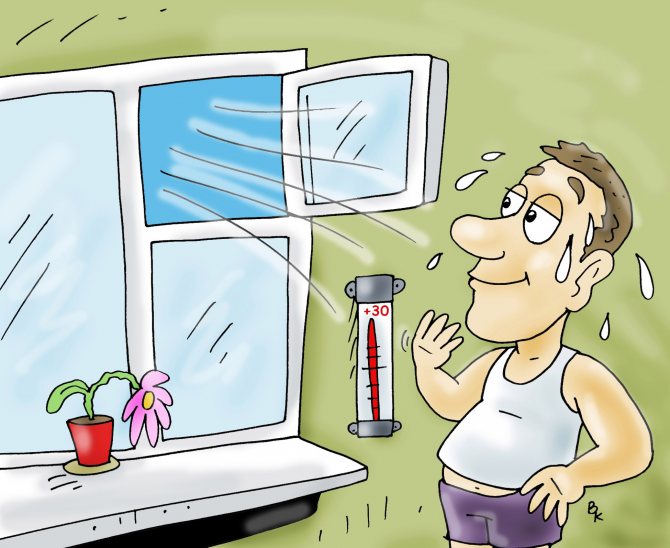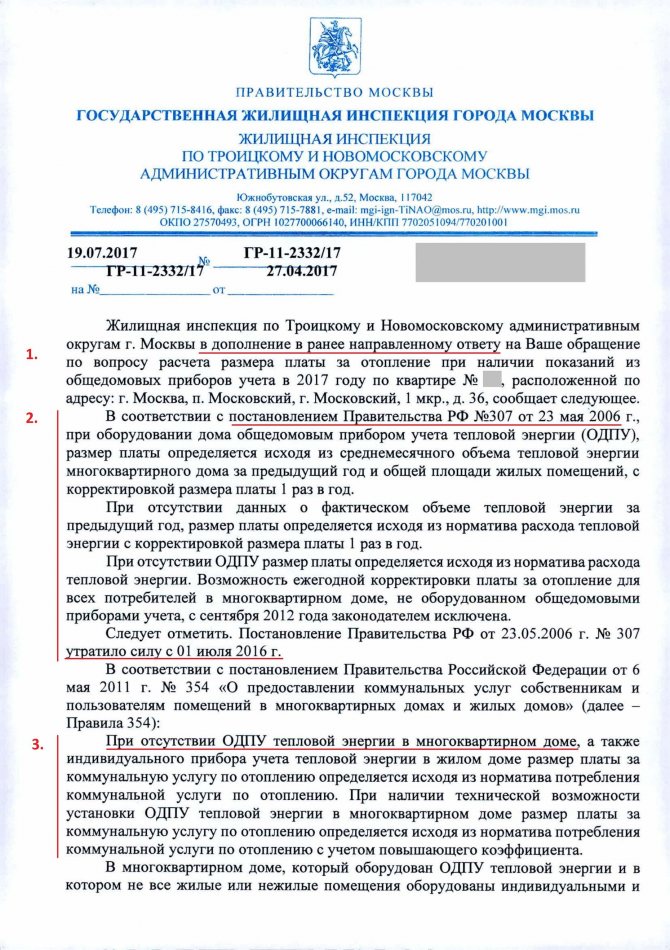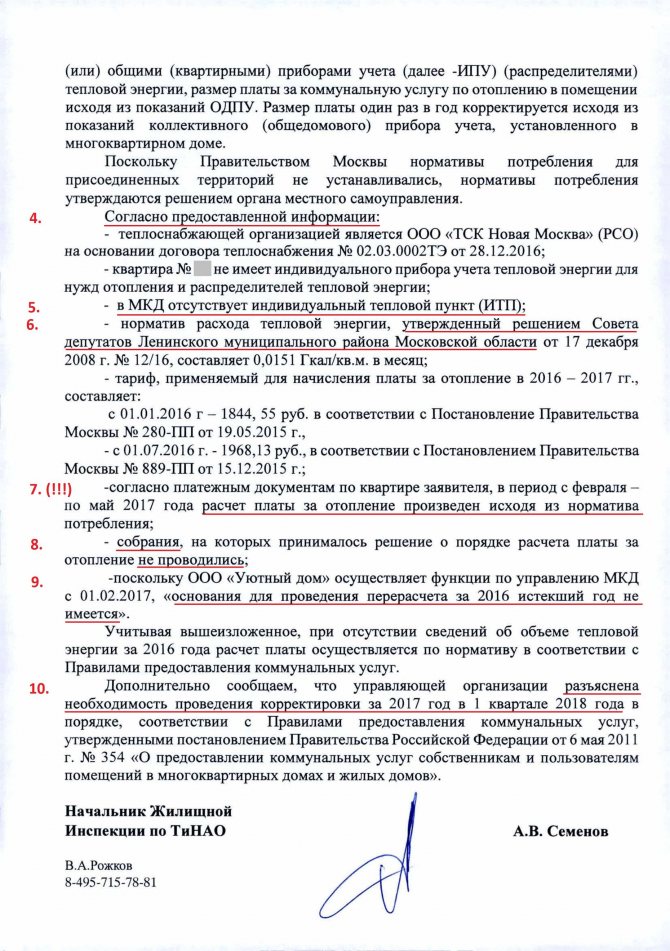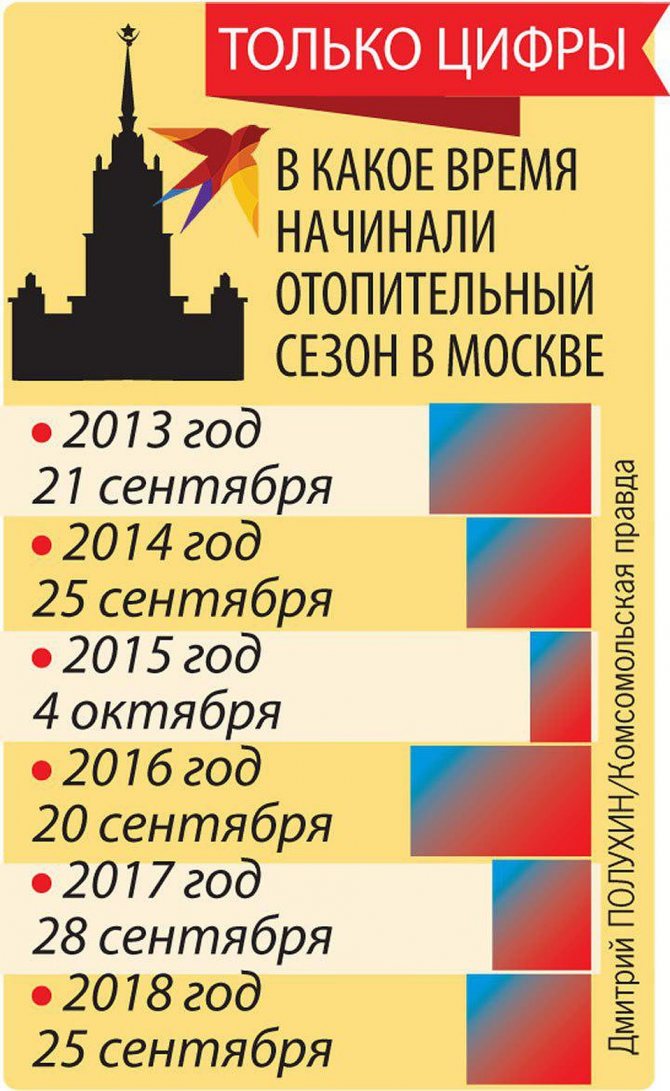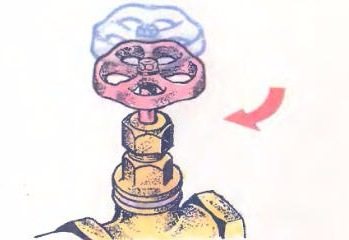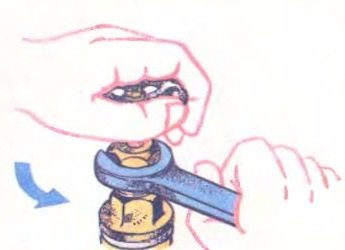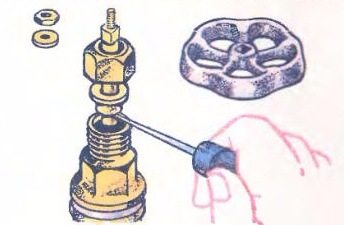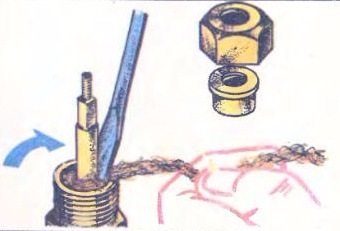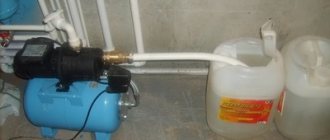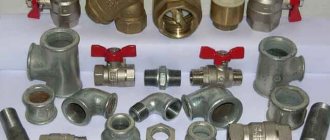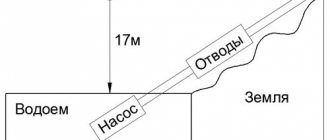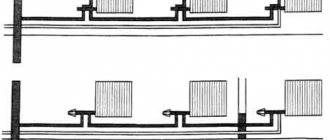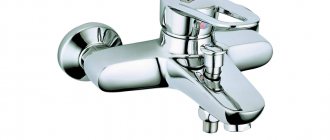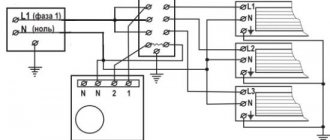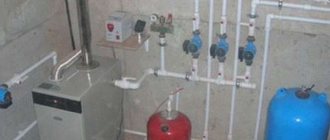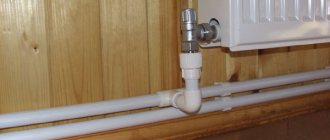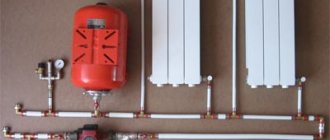Legal subtleties and nuances when disconnecting central heating
There is the option of shutting down the district heating without having to apply for a permit. Many of us have rarely seen contracts with public utilities for the supply of heat to your home. A priori, it is believed that the owners of an apartment building agree to the terms of supply of district heating services. In fact, the situation is suspended in the air from a legal point of view. There is no contract, no obligation.

Moreover, in almost every house you can find residents who have arbitrarily disconnected from the heat supply and have managed to equip their apartments with autonomous heating systems. There are practically no cases of prosecution for arbitrariness in this situation, so everyone decides the situation at their own peril and risk.
Consider situations when the consent of the residents of your house and neighbors is not required to make your desire to refuse from the services of centralized heating a reality.
Apartment buildings often have incompletely completed technical documentation regarding the heating system. In this regard, it often happens that the elements of the heating system are not part of the property complex of buildings. Despite the fact that in such a situation you will not need to obtain collective consent for the re-equipment of the heating systems in the apartment, official permits from the controlling and service organizations are required.
The reason is that any intervention in engineering networks requires mandatory fixation in the technical documentation. For each house there is a technical passport, which takes into account all the data on the operating heating system. Removal of radiators, insertion and installation of plugs in apartments, any other changes must be reflected in the technical passport. Guided by Art. 26 of the Housing Code of the Russian Federation, for further actions you will need the following package of documents:
- free-form application;
- registration certificate for the disconnected apartment;
- documents confirming the ownership (use) of the apartment;
- written consent of all legal residents of the apartment;
- technical opinion of specialists on the possibility of disconnecting and subsequent re-equipment of communications.
To complete the picture, it is required to attach a reorganization project to the package of documents, which is being developed by specialists of the relevant organizations and authorities. The design documentation must include calculations that prove the functionality of the central heating system in the house in the absence of elements of a disconnected apartment. In addition to the project, it is better to have a scheme of thermal-hydraulic calculations of the facility, an accurate calculation of residual heating.
A technically sound design is the first step to getting a permit. However, if the changes made can negatively affect the thermal efficiency of the entire house and cause a violation of the temperature regime in the apartments of other homeowners, such a project will be rejected.
Uneven heating
Description: in a dead-end two-pipe heating system, devices farther from the boiler or elevator are heated much weaker than those closest. The problem is typical for small-sized heating systems (private houses, shops, cafes, etc.).
The essence of the problem is that in a dead-end system, the radiators and connections connecting the spills form several contours of different lengths. The coolant moves along the path of least hydraulic resistance, through short circuits.The long ones (the ends of the filling and the batteries farthest from the boiler) cool down until the circulation in them is completely stopped.
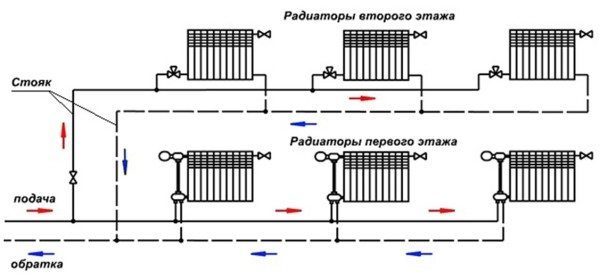

Dead-end heating system of a two-story house.
Decision: dead-end system requires balancing - limiting the passability of supply lines of nearby heating devices. To do this, they are torn apart by chokes. By covering the throttles on the near batteries, we will redirect part of the coolant volume to the distant devices.
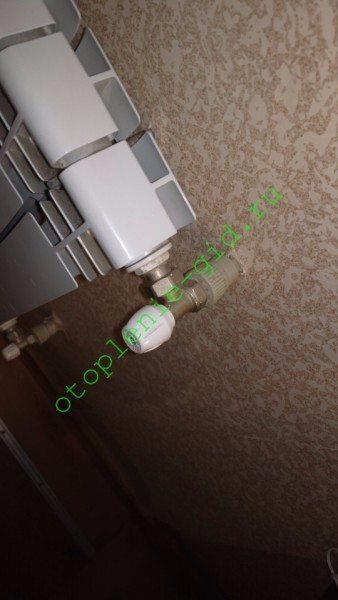

The choke will reduce the flow of water through the battery by redirecting it to other radiators.
When balancing, take into account the inertia of the heating system. After adjusting the chokes, the temperature of the batteries will stabilize within 30-60 minutes.
Why is balancing not required in the heating system of an apartment building with a bottom filling - a typical two-pipe dead-end scheme?
In it, a specific selection of diameters of bottling and risers is responsible for the uniform distribution of the coolant:
- A typical riser has a nominal size (DN) of 20-25 mm;
- The filling is laid with a pipe with a diameter of 40 - 50 mm.
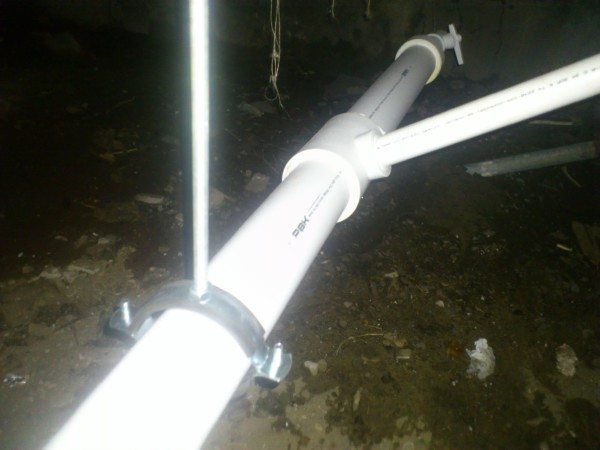

Filling and heating riser. The larger cross-section of the filling pipes replaces the balancing of the risers.
Note: the permeability of the pipe increases in proportion to the square of its diameter. The DN 50 pipe passes four times more water than the DN25 pipe.
Formula for the area of a circle. The permeability of the pipe is proportional to the area of its internal section. Therefore, with an increase in the diameter, the throughput of the pipeline increases following its square.
As a result, the length of the contours formed by the risers closest to the elevator and the risers farthest from it is different, but their hydraulic resistance is practically the same.
Normative base
The normative act describes in detail the nuances of the relationship between the consumer and the resource supplying company:
- terms of preparation of engineering networks for the heating start-up season;
- responsibility for non-compliance with the regulations;
- when and who should repair obsolete communication elements.
Some of the questions about the responsibilities of public utilities are specified in Government Decree No. (last changes were made on May 22, 2019). This legislative act speaks about the terms for the repair of current breakdowns. The options are also listed when the heating must be turned off for technical reasons.
Watch the video: "When they turn off the heat supply in apartments."
Average daily temperature norm for de-energizing and starting heat supply
The average outdoor temperature, which affects the supply of the resource to residential buildings, is defined as the general level of fluctuations per day. For example, in the daytime the sun heats the air to + 15 ° С, and at night the thermometer can drop to -1 ° С. Thus, the average mode is + 8 ° С.
If for three days in a row the street temperature will generally be + 8 ° C, then it is time to start supplying heat.
In the spring, the situation is similar. The heating shutdown in 2020 in Russia occurred subject to the fact that for 3 consecutive days the average daily temperature was at around + 8 ° C.
Season to start heating supply
The heating period is the time when the temperature outside on average for 24 hours is no more than + 8 ° С. At the beginning of winter, the first to connect socially significant buildings: MUSOSH, preschool institutions, clinics, hospitals, orphanages. Then there are multi-storey residential buildings. Industrial facilities are connected last.
At the end of the heating season, the opposite is true. They start to turn off the prom. buildings, MKD and at the end socially significant premises.
Permissible period of lack of heat supply
In addition to the end of the heating season, there are additional reasons when, in the cold season, utilities stop the supply of heat to the apartment building.So, preventive work not carried out in time and major breakdowns on water mains can cause unplanned stops in the supply of heating.
Two laws governing the timing of repair work and responsibility for their failure:
The law provides for a time frame during which utility employees are required to fix the problem:
Table 1.
| Mode | How long can the heating be turned off |
| + 12 ... 18 ° С | 16 hours |
| + 10 ... 12 ° С | 8 h. |
| + 8 ... 10 ° С | 4 hours |
If there is no heat in the house for much longer, you should contact the city's emergency dispatch service. In parallel, experts recommend notifying the management company.
Cold loop
What, besides an airlock, can lead to a stoppage of the heating system in a private or apartment building?
Here is a list of typical reasons for a private home:
- Power outage and stopping the circulation pump;
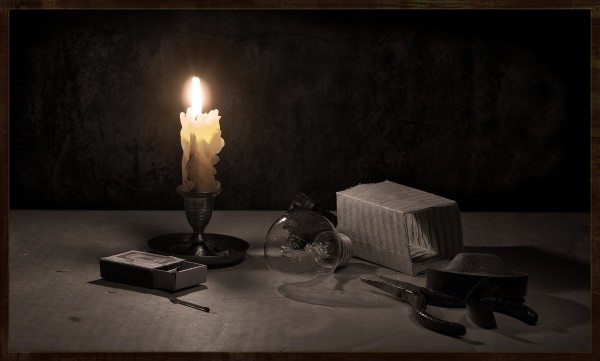

In winter, blackouts are not uncommon at a distance from large cities.
- Valve break screw valve from the stem and its sinking.
This happens if the installation is incorrect, when the coolant enters the valve not from below, but from above. The screw valve body has an arrow indicating the direction of water flow.
In an apartment building, you can add to the list:
- Falling valve cheeks... Due to mechanical wear, the cheeks are torn off the stem and lowered into the through channel of the body, blocking the water flow;
- Clogged risers foreign objects brought by water from the heating main. The sump in the elevator unit should theoretically retain debris, but in practice this does not always happen. I have repeatedly had the opportunity to get wooden chops and large pieces of welding slag from the risers;
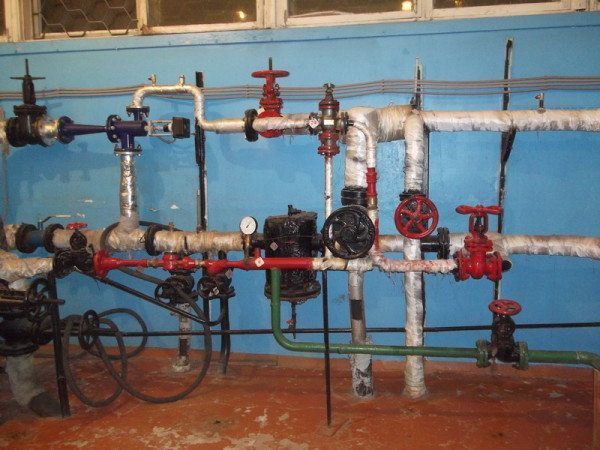

The black tank is a sump responsible for purifying water from the heating main. Alas, it does not hold all the trash.
- Neighbor manipulation with three-way taps and radiator shut-off valves... A three-way valve in Khrushchev stands directly on the lintel between the connections and in one of the positions completely stops the circulation in the riser. The taps on the connections can close it only in the absence of a jumper.
Stopping the pump
Description: when the circulation stops, the boiler continues to heat the coolant until its temperature reaches the thermostat trigger point. At the same time, the operation of a diesel or gas boiler stops; the solid fuel device continues to heat the water for some time, which usually leads to the operation of the safety valve in the safety group and the loss of part of the coolant.
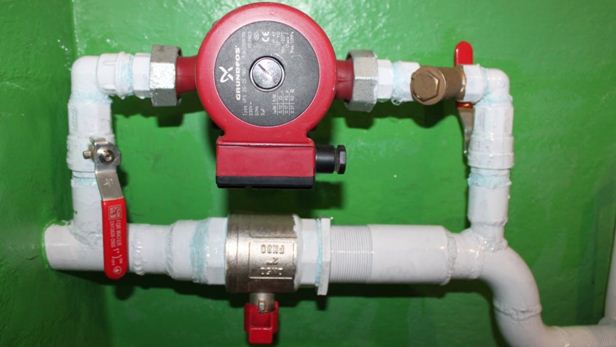

The pump is responsible for circulating water in the circuit. The photo shows its insert into the heating circuit.
Article on the topic: Gas heating boilers Vilant - warmth and comfort in every home
Decision: Power the pump with an uninterruptible power supply. With a power consumption of 50-70 watts, an inexpensive UPS is enough for two to three hours of operation.
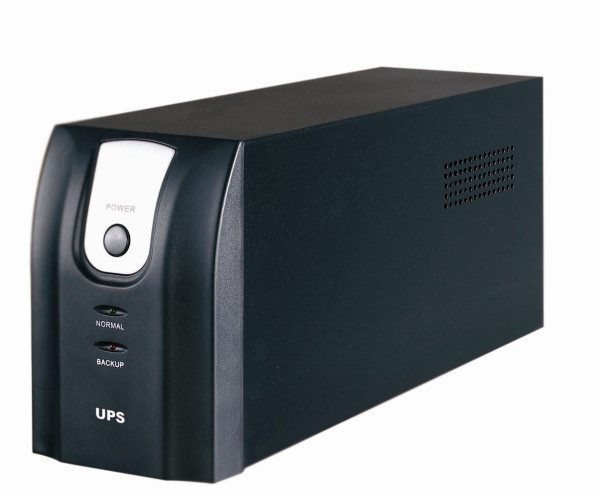

The UPS will keep the pump running when the lights are turned off.
Most of the problems are caused by the failure of the pump installed by the manufacturer in the boiler body. In this case, the owner will have to contact the organization that provides service for the heating equipment.
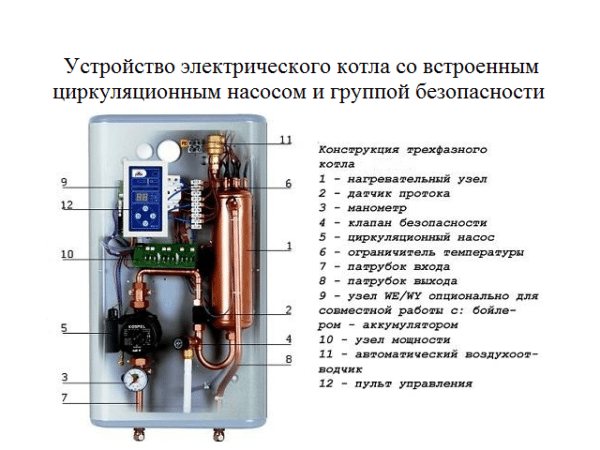

A modern boiler with a built-in pump is not the most reliable solution.
Valve break
Description: if the screw valve is not fully open, the valve is continuously dangling in the turbulent flow of water passing through the hole in the seat. Sooner or later, the wear of the stem leads to the separation of the valve, which is pressed against the seat by the flow and completely stops circulation.
Decision: valve replacement with a modern ball valve. It is much more fault-tolerant, does not require maintenance (periodic packing of the gland and replacement of gaskets) and can be installed in any position with respect to the direction of flow of the coolant. At the same time, the price of the crane differs little from the cost of the screw valve.
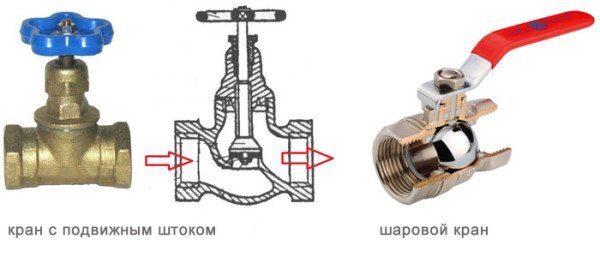

Unlike a screw valve, a ball valve is indifferent to the direction of movement of the working medium.
Falling valve cheeks
Description: in a wedge gate valve, the gate is two cast iron cheeks with brass rings, which are pressed against the mirrors - the same rings in the valve body. The cheeks are held on a bulge at the end of the stem. When the valve closes, they are bursting with a wedge installed between them.
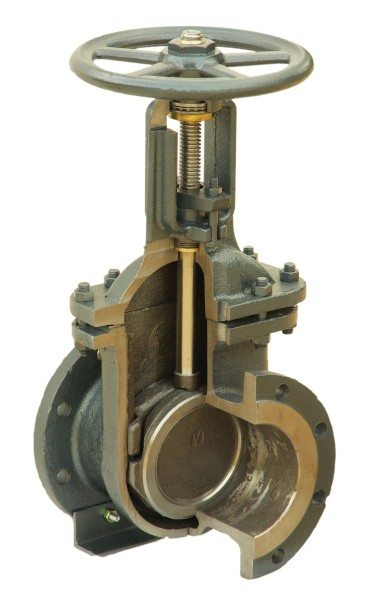

Sectional Wedge Gate Valve.
As soon as a wedge or a thickening on the rod is worn enough, the raised cheeks fall into the body, where the pressure of water presses one of them against the mirror.
Decision: valve repair is carried out by welding a wedge or stem. To access them, you need to remove the housing cover when the heating is dropped by unscrewing a few bolts.
The management organization is responsible for the repair of heating systems in apartment buildings. An attempt by a tenant to fix the valve with his own hands will only lead to a conflict with housing dwellers and, most likely, to an administrative penalty, since you interfere with the work of public engineering systems.
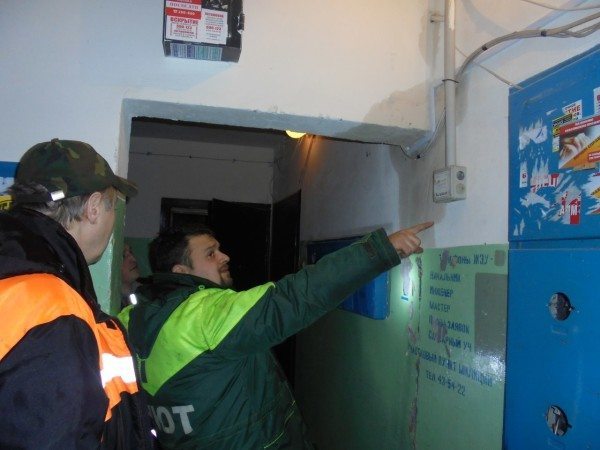

If there is no heating in an apartment building, you need to go not to the basement, but to the management company.
Blockage
Description: large debris brought by water from the heating main, usually stops under the seat of the screw valve. As a rule, the circulation does not stop completely, but slows down: the neighboring risers heat normally, and the problematic one barely warms up.
Decision: when the heating system is completely reset, unscrew the valve head and remove the cause of the blockage from under the seat with tweezers.
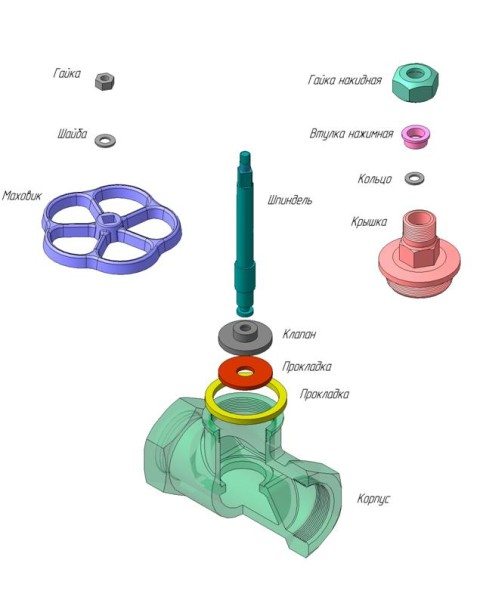

Screw valve device. When properly installed, large debris will stop under the saddle.
Closed taps
Description: a three-way valve in an abnormal position or a valve on connections not connected by a bypass completely stops the circulation in the riser.
Decision:
- In a house with three-way taps, you need to go around all the apartments along the riser, checking the position of the crane handle: normally it should look towards the radiator or jumper. If the handles are removed, look for scratched or peeled paint on the stem. After turning the valve to its normal position, the riser should heat up within 3-5 minutes;
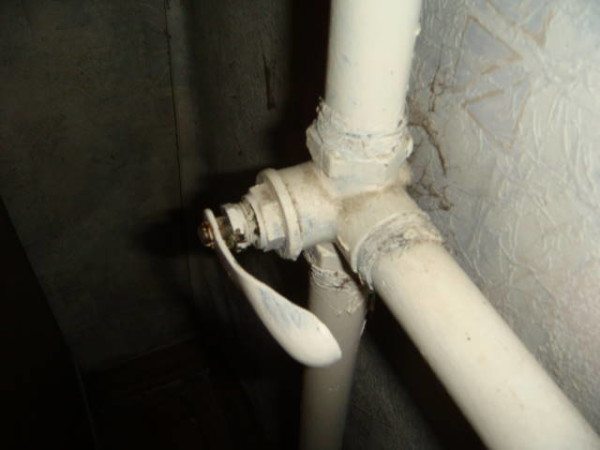

In this position of the tap, the coolant circulates through the radiator, bypassing the bulkhead.
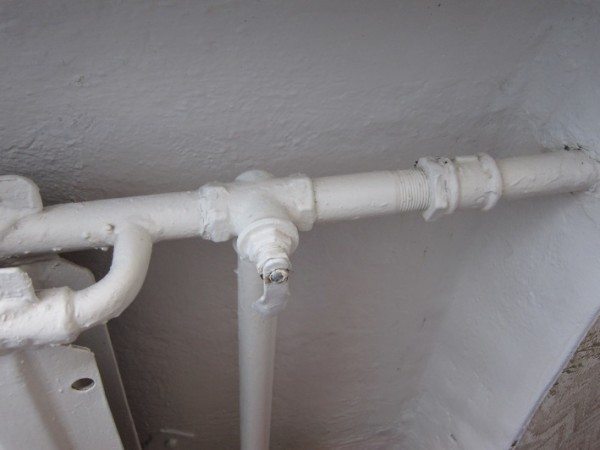

With this position of the tap handle, all the water flows through the jumper.
- If your home does not have three-way taps, look for a closed valve or choke on the liner without a jumper. To resume circulation, it is enough to open it, and after the end of the heating season, it is worth installing a bypass between the connections.
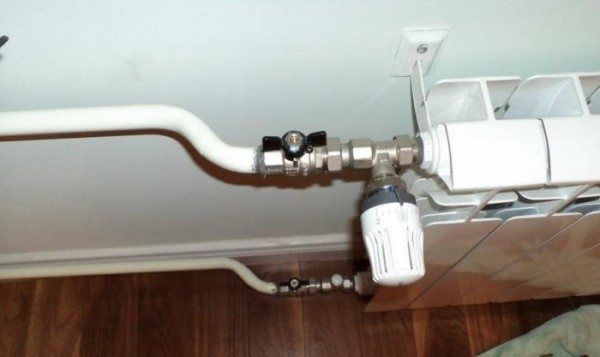

Without a jumper in front of the radiator, a thermal head installed on the liner will choke the entire riser.
When the heating is turned off in 2020
According to forecasters, the end of the heating season in 2020 will already begin on the 20th of April and, depending on the regions, will end in May.
The shutdown of the heating system by law occurs subject to several conditions:
Outside atmosphere temperature. According to Decree No. 354 "On the provision of utilities ...", the end of the heating season is the time when daytime temperatures stay above 8C for 5 days. This condition applies to those houses where the coolant enters the engineering systems of the house through centralized networks. If this utility service is provided using common house equipment, then the end date of the heating season is determined by the owners of the premises in the house by holding a meeting and drawing up a decision. If this is not accepted, then they use the norms of the above Resolution.
Seasonal fit
When turning off the heat, the time is also taken into account when the shutdown of equipment by heat supply organizations is considered the most favorable. For central Russia, this is the period from April to mid-May.
It is then that the shutdown will be comfortable enough for the population and equipment.
As a rule, the end of the season for supplying heat to houses is coordinated with the meteorological services. They can predict whether a sharp downward temperature change is possible over the next 10 days. If this is not foreseen, then you can stop supplying heat to the houses with the onset of the first two conditions.
The final decision on stopping heat supply is made at the level of local authorities. Therefore, it is not always worth scolding the utilities that manage the house. In this case, they are only performers.
Schedule of heating shutdown in regions of Russia in 2020
Local authorities plan to turn off the heating by May 1.
| Region | Planned heating shutdown date |
| Moscow | 26 April |
| Moscow region | 24 april |
| Tver | May 3 |
| Lipetsk | 23 april |
| Vladimir | 23 april |
| Omsk | the 6th of May |
| St. Petersburg | may 13 |
| Minsk | 2 april |
| Ust-Kamenogorsk | 23 april |
| Mound | 5 May |
| Yaroslavl | April 27 |
| Tula | April 28 |
| Novokuznetsk | may 13 |
| Voronezh | April 22 |
| Ufa | the 6th of May |
| Khabarovsk | The 1 of May |
The transition to summer mode and the shutdown of heat supply systems occurs in stages. First, this happens at industrial facilities, then office and administrative buildings and premises are turned off. Then comes the turn of residential buildings and only at the last moment the social sphere: hospitals, schools and kindergartens.
More about maintenance and repair
Repair of heating systems is most often the result of the fact that the survey has not been carried out for a long time. And if things have come to an extreme, then you need to at least know what to do in a critical situation. To do this, it will not be superfluous to get acquainted with the main types of malfunctions of heating systems - some of them can be easily corrected on their own, but some will have to be left to specialists.
Types of heating systems defects and methods of their elimination
As an example, the procedure for eliminating the most common breakdowns of a typical heating system is considered.
- pipe burst - is a consequence of excessive thinning of the wall and with a possible water hammer. The only way to repair is to replace the damaged area. As a temporary measure, you can consider the imposition of a repair clamp, the price of such a device is cheap, so the repair will not be very expensive;
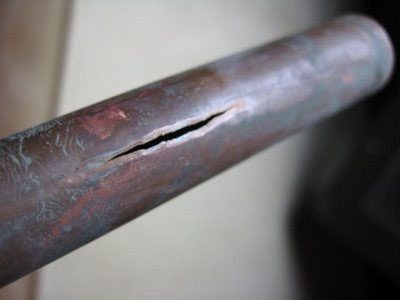

Pipe crack
- leakage of joints - if a detachable connection is used, then it is enough to turn off the heating system for a while, disassemble the connection and reassemble it using linen winding. It is possible that this will fix the problem;
Note! In addition to turning off the heating, you will also need to drain the coolant from the pipe. So this is a rather troublesome task.
- lukewarm batteries - a typical indicator that the channel inside the radiator is clogged and only cleaning it will help. If a bypass was installed in front of the battery, then you can do without turning off the heating, it is enough to turn off the battery from the heating circuit, remove, drain the coolant and clean it. You can also do this task yourself;
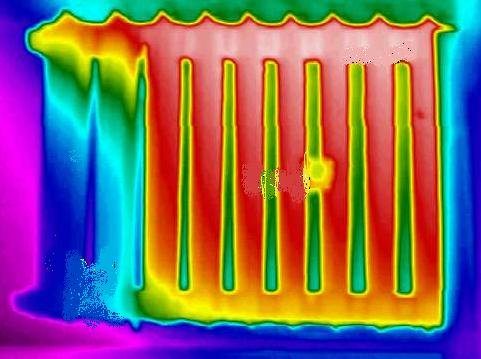

The thermogram of the battery clearly shows that the extreme sections almost do not work
- leak between battery sections - most likely, the nipple has burst; to eliminate the breakdown, you need to completely sort out the battery.
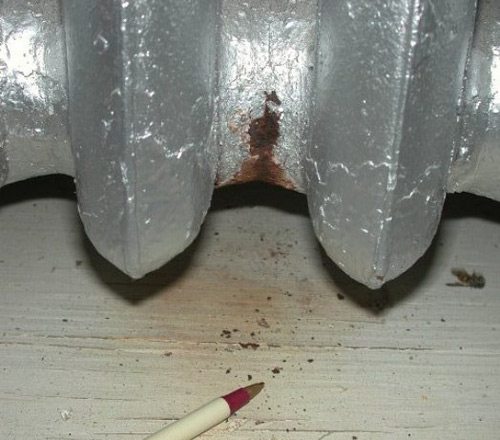

Battery leakage location
Problems can also be observed with the circulation pump:
- after a summer downtime, quite often the pump simply does not rotate, the reason for this is shaft oxidation. In this case, you will have to remove the engine and manually turn its wheel;
Note! In low-power models, it is sometimes possible to turn the shaft using an ordinary screwdriver; the manufacturer makes a notch at the end especially for this.
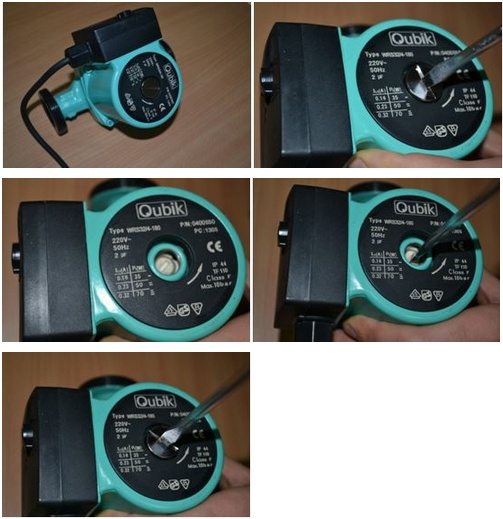

The shaft can be turned with a simple screwdriver
- in the absence of a filter in front of the pump, a foreign object can simply block the operation of the device. In this case, it is enough to manually dismantle the casing and remove it;
- the cause of periodic spontaneous shutdowns of the pump may be a thick layer of scale on the stator jacket, the repair manual consists of descaling the stator jacket;
- a damaged fuse can also cause problems with starting the pump;
- strong vibration is a consequence of bearing wear, in which case only replacing it will help.
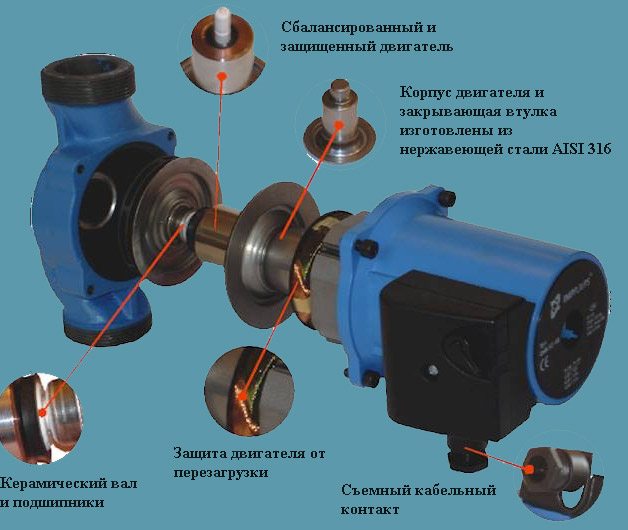

Circulation pump device
In addition to those listed, there are also problems with the electrical part of the pump. For example, if a 3-phase pump is incorrectly connected to the network, a reduced head is observed, and the required circulation of the coolant is not ensured.
On the work of special services
To maintain the heating system in working order, it must be regularly inspected by specialists.
Also, the list of services provided by specialized companies includes emergency, current and overhaul types of repairs:
- emergency repair - the elimination of problems that have arisen directly during the heating season is carried out. This can include the elimination of such malfunctions as a fistula on the pipe, lack of hot water in the riser, leakage of the heating radiator, etc. In any case, to eliminate the malfunction, it is necessary to turn off the heating of a part of the house, so that the work is carried out as soon as possible;
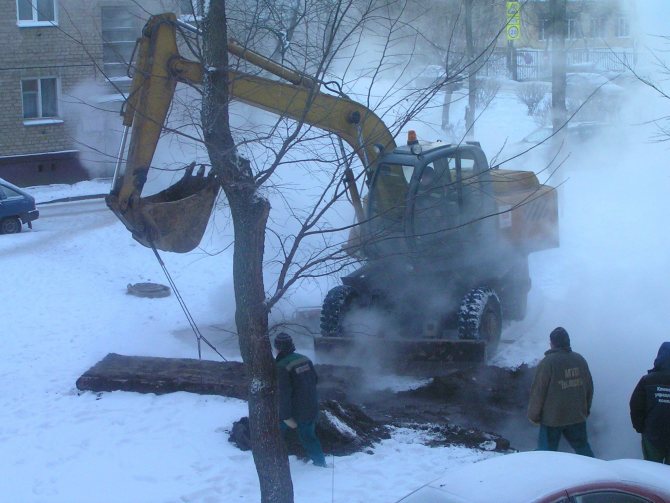

A classic example of a breakthrough of a worn-out heating main
- Maintenance - carried out in preparation for the heating season. The list of works includes checking all valves, if necessary, rewinding locknuts, eliminating fistulas on pipes, replacing heavily rusted heating pipes;
Note! Modern linen rolls have an unpleasant feature - they fade over time. Therefore, they have to be restored periodically.
- overhaul a defective statement must be drawn up for the upcoming types of work, indicating the types of work and the cost of materials. Work is underway to completely replace heating pipes, radiators, install new valves, etc.
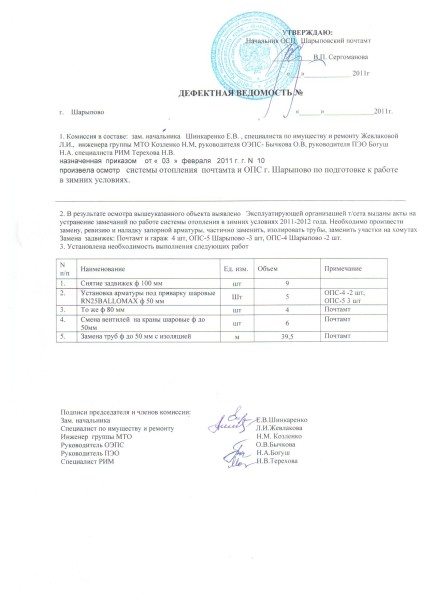

An example of a defective statement
From the point of view of the law, the customer is obliged to hold a tender for the execution of capital repairs. Ideally, a dozen or two organizations will compete for the right to perform work, and in the end the one that takes up the task at the lowest cost will win.
In practice, overhaul is often given without a tender to the service organization. This acts as a kind of quality guarantee - after all, it will not be profitable for this company to try to deceive the customer.
Note! Only those enterprises that have the right to provide heating repair services are allowed to submit applications for participation in the tender, that is, according to the classifier, the OKDP code 453 was indicated during registration.
Preparing for the heating season
It is clear that summer and early autumn can be considered the ideal time to prepare for the heating season. The heating system does not work at this time, so nothing will prevent a specialist from checking each of its elements.
Specialized companies in preparation for the heating season, as a rule, offer a comprehensive check of all components of the heating system, from checking the tightness of the joints and ending with checking the operability of the circulation pump.
The list of services provided includes:
- inspection of the heating boiler (important for owners of autonomous heating), replacement of defective parts;
- checking the operation of the circulation pump, cleaning it;
- checking the degree of pipe clogging, wall thickness;
- cleaning radiators under pressure;
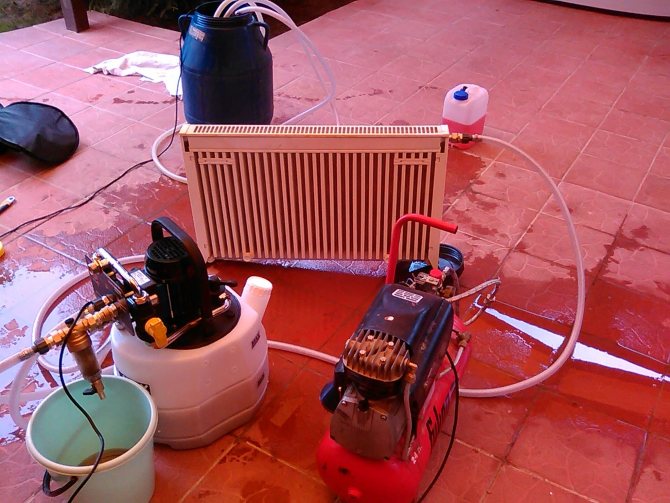

In the photo - flushing the radiator under pressure
- checking the tightness of control valves, replacing them;
- replacement of worn-out pipe sections with new ones;
- system operation diagnostics.
It is also important that such companies give a guarantee for the work performed. So in winter, in the event of an emergency, elimination of the consequences will be performed free of charge.
Answer
Disconnection can be made due to arrears in payment for services rendered, due to revealed facts of non-contractual consumption, due to accidents, etc. (Clause 76 of the Decree of the Government of the Russian Federation of 08.08.2012 No. 808). Disconnection for other reasons is unacceptable.
The rationale for this position is given below in the materials of "Sistema Yurist"
.
DECISION OF THE GOVERNMENT OF THE RUSSIAN FEDERATION dated 08.08.2012 No. 808 "On the organization of heat supply in the Russian Federation and on amendments to some acts of the Government of the Russian Federation"
"76. Limitation and termination of the supply of heat energy to consumers can be introduced in the following cases:
non-fulfillment or improper fulfillment by the consumer of obligations to pay for heat energy (power) and (or) coolant, including obligations for their advance payment, if such a condition is provided for by the agreement, as well as violation of the terms of the agreement on the quantity, quality and values of thermodynamic parameters of the returned coolant and (or) violation of the mode of consumption of heat energy, significantly affecting the heat supply to other consumers in this heat supply system, as well as in case of non-compliance with the mandatory requirements established by technical regulations for the safe operation of heat-consuming installations;
termination of the parties' obligations under the heat supply agreement;
identification of the facts of non-contractual consumption of heat energy (power) and (or) heat carrier;
occurrence (threat of occurrence) of emergency situations in the heat supply system;
the presence of a consumer appeal to impose a restriction;
other cases provided for by the regulatory legal acts of the Russian Federation or the heat supply agreement *. "
In recent years, there has been a steady trend among homeowners in apartment buildings to switch to autonomous heating options. The increased financial capabilities of apartment owners make it possible today to provide heating in an apartment at a completely different, higher technical level. This is largely facilitated by the emerging autonomous devices and units, which are highly efficient and economical.
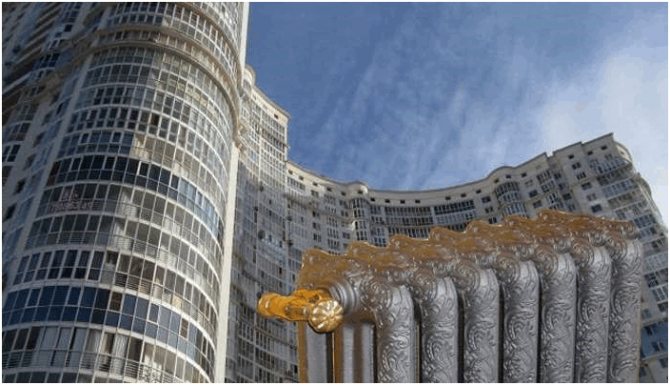

The desire to make your apartment completely independent from centralized heating supply is quite understandable and understandable. Often, the quality of the heating system in winter leaves much to be desired. Barely warm batteries, when winter is fierce outside the window, unreasonable financial expenses are real prerequisites for completely abandoning heating in an apartment.
Causes of malfunctions in heating
Most residents of city apartments believe that they do not need to know the structure of engineering systems. Any problems of central heating that appear in their high-rise building are obliged to solve the employees of the management company. And it is right. It is better if only one responsible owner is involved in all the affairs. Indeed, in an apartment building, heating problems often arise precisely because of unauthorized interventions in the smooth functioning of the heating system.
But individual homeowners are forced to understand the heating problems in a private house and keep the situation under their control. The owner of the house should at least in general terms know about the causes of problems and be able to fix them.
The following reasons can lead to problems with the heating system:
- the system is incorrectly designed;
- the equipment does not meet the design requirements;
- the system is unbalanced due to unauthorized connections;
- the installation was performed poorly;
- air locks interfere with the circulation of the coolant;
- radiators are installed incorrectly;
- pipelines have fallen into disrepair;
- the tightness of the connections is broken.
Let's take a closer look at each of these reasons and ways to eliminate heating problems in an apartment and in a private house.
Where to call if the heating is turned off hotline for complaints
Calls about heating should initially be at the office of the management company and the emergency service of the area. Sometimes the service provider has no information that the heating supply to the house has been interrupted. In other situations, the Criminal Code employees do not respond to complaints.
In this case, you need to call special hot lines for heating.
The following services operate in Moscow and the Moscow region, regulating the situation with the supply of heat supply:
Table 1.
| Contacts | Organization |
| +74955395353 | Round-the-clock telephone for housing issues. Unified dispatching office for utilities. |
| +74955395959 | United Energy Company |
| +74956809861 | Housing and communal services |
| +74956817367 | Moscow Department of Housing and Communal Services. Directly supervises issues of water resources, sewerage and heating. |
| +74956810549 | The second number of the dispatching office of the Ministry of housing and communal services. It is also worth calling here if the heating is turned off. |
| +74956202760 | Emergency service for road accidents and pipeline repairs located under the roadbed. |
| +74957758770 | The center of the urban economy of the capital. |
| +74997633434 | Vodokanal stronghold |
| +74956578703 | The organization that controls the work of gutters. |
A complaint can be sent remotely through the websites of local municipalities:
Table 2.
| Office | Link to the official portal |
| Moscow administration | |
| Electronic reception of the mayor | |
| MOEK | |
| Public services | |
| "Moscow is our city" | |
| GZI | |
| Ministry of Housing and Public Utilities | |
| Government of MO |
Alternative heating options. Reality and consequences of this step
The main argument that is guided by the owner of the apartment, who wished to disconnect from the heating plant and make autonomous heating in his house is independence. A characteristic feature of our country is the rapid change of seasons. Summer ends quickly, the heat accumulated in houses during the warm period quickly evaporates. For many of us, waiting for the official start of the heating season is associated with discomfort. There is still a lot of time before the date of turning on the centralized heating, but the apartment is already cold and not comfortable. There is a way out, and it just suggests itself.
Your own self-contained boiler is able to solve such problems once and for all. But how to turn off the centralized heating in your apartment in order to independently make decisions when, how much and for what to pay? All these questions require careful analysis and a competent approach. The main problem is huge bureaucratic work. In order to once and for all refuse the services of a regional energy company, a lot of permits and related documentation will be required.
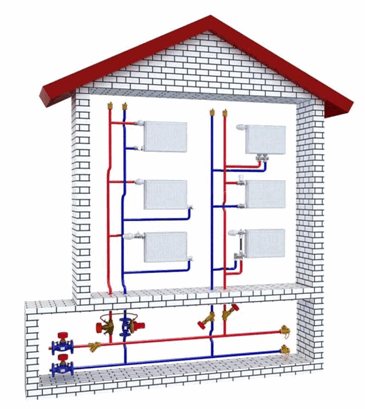

Any unauthorized intervention in the system can lead to a malfunction of the entire complex as a whole. Turning off one apartment from a single heating system will require re-equipment of the entire network and is associated with a large amount of engineering and technical work.
The entire system, in accordance with the norms of the legislation, is part of a single property complex, which belongs to an apartment building. The composition of the property of a residential building, its functionality and performance is determined by the homeowners. The conclusion suggests itself - decisions on making changes to the district heating system are made collectively. This requirement is clearly spelled out in the Housing Code. Disconnection of one apartment is an individual decision. However, unauthorized shutdown without obtaining appropriate permits and approvals is punishable by law.In some cases, such actions by the owner of the apartment can be classified as a criminal offense. Any work related to engineering networks in an apartment building must be performed by specialists, guided by the appropriate permits, terms of reference and project.
Advantages and disadvantages of an autonomous heating system
As a general rule, produced, transmitted, consumed energy resources are subject to mandatory accounting using metering devices for energy resources used (part 1 of article 13 of the Federal Law of November 23, 2009 No. 261-FZ “On energy saving and on increasing energy efficiency and on making amendments to certain legislative acts of the Russian Federation ”, hereinafter - Law No. 261-FZ).
If the house was commissioned before November 29, 2009 (that is, before the start date of Law No. 261-FZ), then the house owners, by January 1, 2011, were obliged to provide the house with heat metering devices.
In turn, according to Part 12 of Art. 13 of Law No. 261-FZ, clause 38.1 of the Rules for the maintenance of common property in MKD (approved by Decree of the Government of the Russian Federation No. 491 of August 13, 2006, hereinafter referred to as the Rules) in case of failure to comply with these requirements of the law within the specified time, the MKD is equipped with metering devices organizations or organizations providing heat transfer services, at the expense of persons who have not fulfilled the obligation to install them within the prescribed period.
These organizations issue invoices for the payment of the costs of installing metering devices to the owners of premises in an amount proportional to their shares in the right of common ownership of common property. The owners of the premises are obliged to pay these costs, unless such costs were included in the payment for the maintenance and repair of the residential premises.
Read more about the procedure for installing a common house metering device and paying for expenses in the response of the GARANT Legal Consulting Service at the link.
The court did not confirm the owner's argument that he did not consume heat energy, since he disconnected the premises from the centralized heat supply system of the apartment building. The non-residential premises are equipped with autonomous heating equipment.
In accordance with paragraphs. "In" clause 35 of the PP of the Russian Federation No. 354, the consumer has no right to arbitrarily dismantle or disconnect heating elements, regulate the in-house equipment of the heat supply system. These actions can lead to a decrease in air temperature in all rooms of the house and an increase in the volume of consumption of utilities.
According to clause 1.7.1 of Regulation No. 170, the refurbishment of residential and non-residential premises in MKD is allowed only after obtaining the appropriate permits from the municipality. The completion of such a reorganization is confirmed by the act of the acceptance committee (part 1 of article 28 of the RF LC).
The court referred to the ruling of the Constitutional Court of the Russian Federation dated 10.07.2018 No. 30-P, which states that the ICM is an integral system. Therefore, the owner of the premises cannot completely refuse to pay for heating services at home, including common areas that are part of the common property of the house.
The owner of the non-residential premises did not provide the court with evidence that the insulation of the risers in the room, the disconnection of radiators and the installation of autonomous heating equipment were carried out with the receipt of permits, and the room was completely disconnected from the heating supply of the house. Therefore, he cannot be exempted from paying for the supplied heat energy.
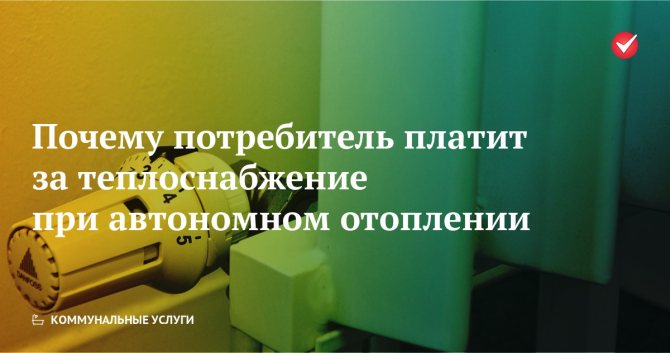

An important circumstance in the court case was also that the batteries in the room were not dismantled: they were only covered. This did not allow the owner to appeal to the legal position of the Armed Forces of the Russian Federation, set out in the definition of August 30, 2016 No. 71-KG16-12.
In this definition, the RF Armed Forces noted that the fact that networks pass through non-residential premises in the absence of heat receivers does not give grounds for collecting heating fees from the owner. Since the heating radiators in the premises of the individual entrepreneur were not dismantled, the court of first instance did not take into account the reference to the definition No. 71-KG16-12.
Having examined each argument of the owner, the court came to the conclusion that the executor of the CU has the right to collect from the consumer the entire amount of debt and penalties for late payments.
By filing an appeal, the owner of the premises tried to prove that the heating system in his premises was reorganized in the manner prescribed by law.
He pointed out that the heating radiators were blocked by the building management organization with the installation of seals, and the pipelines were insulated, ventilation with an air heater was installed in the room as an alternative to the centralized heating system. Consequently, the district heating service was not provided to him.
The Court of Appeal, considering the complaint, noted that the house in which the defendant's non-residential premises are located has a single communal heating system. The owner of the premises did not provide evidence that his premises are structurally located separately from the apartment building and do not have common engineering systems with those inside the building or have a separate insulated heating input.
We invite you to familiarize yourself with Tramway intersections
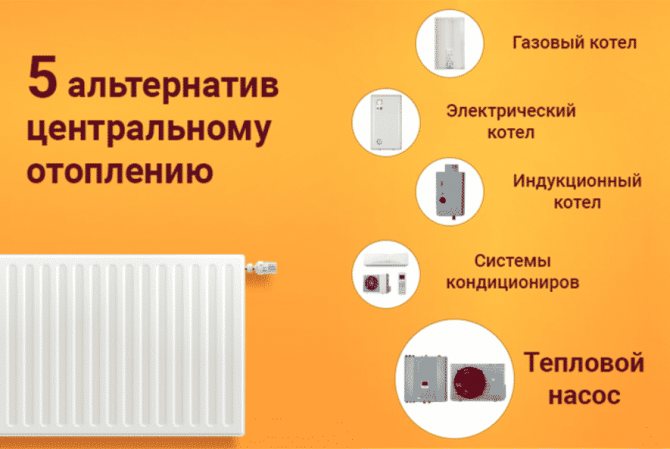

The consumer does not have the right to arbitrarily dismantle or turn off the heating elements provided for by the technical documentation of the house, to make changes to the building engineering systems (clause 35 of the RF PP No. 354).
Any intervention in the common house engineering networks requires an agreed project and changes to the technical documentation of the house. According to Part 1 of Art. 26 of the RF LCD, the reorganization is carried out in compliance with the requirements of the legislation in agreement with the local government.
If the heating radiators in the premises, the placement of which is provided for by the technical documentation, are disconnected, the consumer can be exempted from paying for heat supply services only on one condition: if he provides evidence that this has been done in compliance with the procedures of coordination with the LSG bodies. The approval of the managing organization or the acts of other specialists do not matter.
The Court of Appeal upheld the decision of the first instance. The Cassation Court confirmed this position, and the Supreme Court of the Russian Federation did not consider the complaint, agreeing with its colleagues.
Where to complain if the heating was turned off illegally
There are legal and unauthorized grounds for suspending the supply of heating to residential buildings and premises.
In the event of major emergencies on central heating systems, there is a clear limit on the time frame for de-energizing the resource:
- 16 hours of downtime in heating while maintaining room temperature at 12 ° C-18 ° C;
- an eight-hour interruption in the supply of heat, provided that the temperature in the apartments is maintained at least 10-12.
- no more than 4 hours, if the set mode in the living quarters is kept at the level of 8 ° С-10 ° С.
Delays in heat supply to apartments for longer than specified is considered illegal. It is impossible to keep silent about this fact - you should call if the heating has been turned off to the supervisory structures. Additionally, a complaint is filed.
Initial complaints should be made directly to the home service company. The management of the managing organization must respond immediately. within 2 hours create a commission and consider the situation on the spot.
Emergency services are supervised by unified dispatch centers, which are also worth calling.
In the absence of a response, it is necessary to file a claim with the regulatory authorities:
- Housing inspection.
- Rospotrebnadzor.
- Municipality.
- The prosecutor's office.
- Court.
Before going further down the chain of command, it is necessary to inform the leadership of the Criminal Code or the housing and communal services - as a peaceful settlement of the problem. Often times, the situation is resolved at this stage, as utilities understand that further complaints will lead to proceedings and unscheduled inspections.
Supervisory authorities
The main bodies whose competence is to monitor and punish management companies and housing and communal services:
- Housing inspection;
- Rospotrebnadzor.
How to make a complaint about the lack of heating in the house
When filing a complaint, it is important to adhere to a business style, i.e.
less emotion and more facts.
Mandatory information:
- The title and name of the person to whom the claim is being written are indicated in the header of the application.
- The text of the appeal describes in detail the time and place of the incident.
- References are given to the clauses of the service agreement with the Criminal Code and legislative acts.
Samples of a complaint about a lack of heating are available here:
- In the name of the director of the management company.
- In GZI.
- To Rospotrebnadzor.
- The prosecutor's office.
Why heating problems, causes of breakdowns
The heating system in the house combines many different devices and parts. The most significant elements are the boiler, radiators, piping. The attention of the owners is drawn to them most of all. But there is also a "trifle", the price of which is much lower.
This does not mean that they are less influential. And their selection, installation, adjustment should be done as meticulously as the main ones. Otherwise, malfunctions may occur. What causes a malfunction in the heating system? What is the reason for the occurrence of violations and what should be done to prevent them?
To make a high-quality installation of a heating system or maintain it at the proper level, it is necessary to understand the role of each element. Due to insufficient attention to some details, problems arise in the heating of the house.
Consider what kind of violations occur, as well as individual units and assemblies that significantly affect the performance.
Heating pump
Automated boilers are equipped with a built-in pump. And solid propellants need to be supplied with them separately. In addition, in a branched heating system, several pumps may be needed - for each circuit. For example, for underfloor heating and for a boiler, etc. An example of a circuit with 3 pumps is shown in the figure.
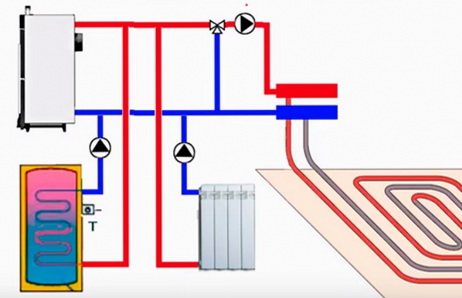

The pump of a solid fuel boiler is installed on the return pipe, because here it will not be influenced by liquid vapors. If the boiler boils, then the pump installed on the supply will stop distilling the coolant, which can lead to a significant accident. On the return line, the pump, on the contrary, will always prevent stagnation of liquid in the boiler.
On the supply side, the pumps can only be installed in the underfloor heating system after the mixing valve.
The pump is oriented so that the rotor shaft is horizontal. Circulation pumps do not have thrust bearings, so vertical installation is a gross mistake.
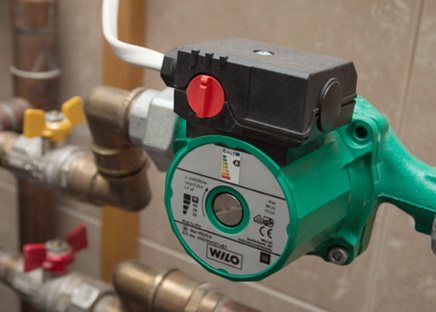

The electrical box must be facing up. If, when installing the pump, it turns out that it turns downwards, then it is necessary to loosen the fastening bolts on the pump itself and turn the box upside down.
Often they try to install pumps with increased power, which is a mistake. Such units can exceed the water flow rate, and noise will appear in the system. In addition, significant unnecessary waste occurs, both for the purchase of the pump itself and for electricity. In most cases, the supply line to the pumps is 25 mm. The pumps themselves are designed for such a connection, as indicated by the first number and in their marking.
Usually for a house with an area of up to 250 square meters. a pump with a pressure of 0.4 atm is sufficient, (for 150 square meters it will always be enough) i.e. for most private houses, 25-40 pumps are sufficient. In large houses, pumps are installed with a head up to 6 m - 25 - 60.
Vent valves and taps
Automatic air vents are one of the important elements of the heating system. One such element must be installed on the safety group at the exit from the solid fuel boiler (there should be no taps between the safety group and the boiler). The device must be immediately set to the operating mode with the regulator. In addition to the air vent, the safety group must include a maximum pressure valve and a pressure gauge.
Automatic boilers, as a rule, are equipped with a standard security system and they do not need additional elements.
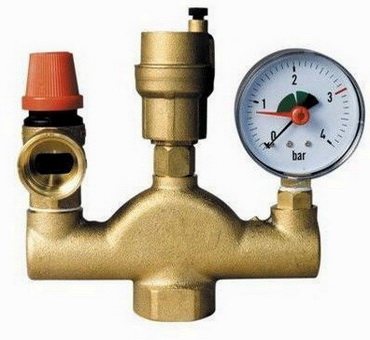

Additional air vents should be installed at the highest points of the heating system and on the collectors - in the supply and return. The heating system must be made without rising pipe loops, which happens when bypassing door or window openings, or other similar obstacles.
If it is not possible to do without the loop, then an air vent is installed in its highest corner (one corner is still made 1-2 cm higher). If this is not done, then the system will be inoperative due to airing. Prefabricated collectors are also supplied with these devices, both on the supply and on the return.
It is better to equip all radiators with manual air vents - Mayevsky taps. And the mounting of the radiators should be carried out with a slight slope, so that the crane is higher. Then it will be easier to remove the air that has entered the system from the system.
Cleaning filter
The cleaning filter is equipped with a mesh inside, on which sludge particles are retained, and then they are lowered into the sump. The filter is installed in front of the boiler on the return line. In the system, rust particles, particles of exfoliated metal and paint are formed, and there may also be silt sludge due to not clean water. The sump must be opened and cleaned periodically. On both sides of the filter, taps must be installed so that the filter can be serviced without draining the system.
The cleaning filter must be installed with a sump down. The vertical arrangement of the filter is not allowed, as sludge will accumulate at the lowest point of the pipeline.
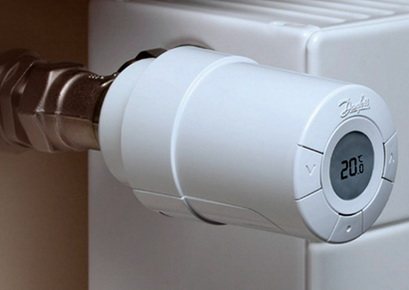

Thermal heads on radiators
Thermostats are installed on the supply to the radiator and turn it off if the temperature in the room exceeds the set one. Then the boiler turns off due to overheating of the liquid, fuel saving occurs. In addition, there are electronic thermal heads that can be programmed, which allows very significant savings on heating.
Thermal heads should not be used in a system with a solid fuel boiler, which cannot stop when a number of radiators are turned off. Overheating of the liquid, its boiling is possible.
Now we will consider what irregularities in the operation of heating are most often due to a malfunction of one or another element.
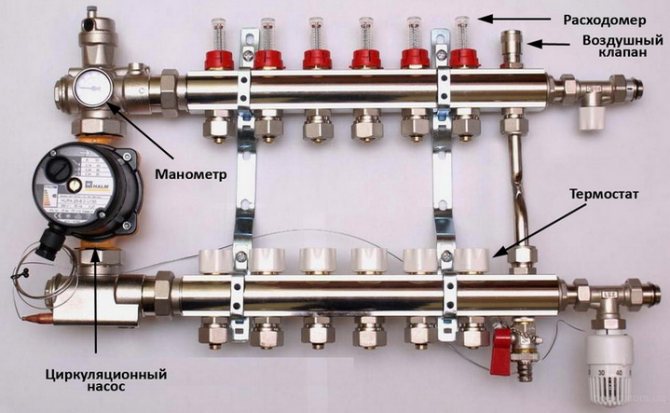

Most common heating system problems
- Fluid flow noise in radiators and pipes. Pipes of too small diameter, or too powerful circulation pump. The diameter of the pipes is selected so that the fluid velocity does not exceed 0.7 m / s at maximum power. You can find out more about the selection of heating system pipes by diameter on this resource.
Also, noise is possible in a separate branch or radiator due to clogging of other circuits or overlapping pipes due to poor installation. Or it is possible to turn off other radiators with thermal heads, which is eliminated by installing a control valve on the supply of a noisy radiator. - Power does not develop, individual heating devices do not heat up. Pump too weak. The system is dirty and the pipes need to be cleaned. What is possible if new water is poured every season, or even new water is combined with steel pipes. During installation, it is necessary to carefully monitor that the shty, dust would not get into the pipes, as they will cause poor heating operation.
It happens that the circuit is not assembled correctly or the sequential switching on of the radiators is applied. Read about choosing the optimal heating scheme for your home. - The system does not work, a separate circuit or radiator does not work. Airing of the system is possible. It is necessary that the upper points of the system or one pronounced point would be equipped with automatic air vents, and the radiators - with manual ones. In case of interruptions in the operation of heating, first of all, it is necessary to check for the presence of air.
We see that violations, malfunctions of the heating system are caused by improper installation and non-observance of operating rules. Heating in a house is always a little complicated, in order for it to function properly, certain rules must be followed.
Possible causes of heating problems
There are reasons that do not depend on the person, the so-called force majeure.
Such circumstances include:
- Natural disasters that caused serious breakdowns on waterways.
- A major car accident on the road that damaged the pavement and pipes underneath.
But much more often, interruptions in heating are associated with negligence in the work of utility workers, such as:
- initially incorrectly drawn up project of heating networks;
- poorly installed insulation of water pipes - for this reason, the lines freeze;
- the system was installed with technical violations;
- lack of level or pressure of liquid in heat transfer fluids;
- uncleaned blockages in the central water supply in time;
- air locks have not been removed from the system;
- breakdowns in the main nodes of resource supply control;
- poorly carried out prevention of heating networks inside a residential building or premises.
Heating standards
In winter, the temperature in the rooms should be as follows:
- In an apartment or house - 18 ° C and above, and in corners it must rise by another 2 degrees.
- Kindergarten - 22-24 ° C for nurseries, for other premises –21-23 ° C. The bedroom is set to a mode not lower than 19 degrees.
- Schools - any room inside an educational institution - 18-24 ° C. In workshops and sports halls - 17-20 ° C.
- The situation with the workplace is more complicated. The indicators depend on the type of load that goes on a person. Therefore, the temperature can fluctuate between 16-18 ° C if the worker is physically involved. Labor in the shop, when the employee stands behind the machine and moves little, involves the establishment of a mode of at least 22-24 ° C.
Statistics of de-energizing heating pipes in houses
If the weather is too cold outside, then the heat supply services have no legal reason to stop supplying heating to residential buildings. The delay in shutdown may be due to anomalies that lead to minor cold snaps in the spring.
If you study the statistics for 2007-2018, you can understand that the battery disconnection in Moscow occurs between the last days of April and the May holidays. It was during this period that the temperature in Russia did not drop below 8 ° C for many days.
The official statistics for turning off heating from 2007 to 2020 shows that heat is given to houses in the period from April 21 to May 10.
Schedule of heating shutdown in regions of Russia in 2020
2019 was no exception for the residents of the Russian Federation in terms of weather. Forecasters did not forecast early warming. In fact, this is what happened. If 5 years ago in mid-April there was already a widespread disconnection of batteries in apartments, then in this reporting period the beginning of the month was more like winter in Moscow and Moscow Region.
In the southern regions, it is relatively warmer, but in early April, average daily degrees drop below the temperature at which heating is turned off according to the law. For example, this year Moscow was cut off from heat on 04/26/2019, Tula - 04/28/2019, Yaroslavl - 04/24/2019, and Tver - 04/29/2019.
What is the heating season
The heating season lasts from the time the utilities turn on the heating until they turn it off. This gap usually begins in the fall and ends in the spring. However, the exact terms are regulated by the relevant authorities.
Heating is supplied through central pipes. There are such constructions in every home. To make it easier for you to understand how central heating works, we suggest that you familiarize yourself with its process in more detail.
How is the process of heating apartments:
- The apartments are heated by piping. Pipes run from the city central boiler house and go to houses and apartments. Here the coolant is water.
- Also, houses can be heated by heat and power plants. In this case, electricity and steam are used as heat carriers.
- The coolant is supplied through a developed pipe system. The pipes run in two rows. According to the first, the coolant enters the apartments, according to the second, it returns from them.
- In apartments, heat is distributed through pipes.
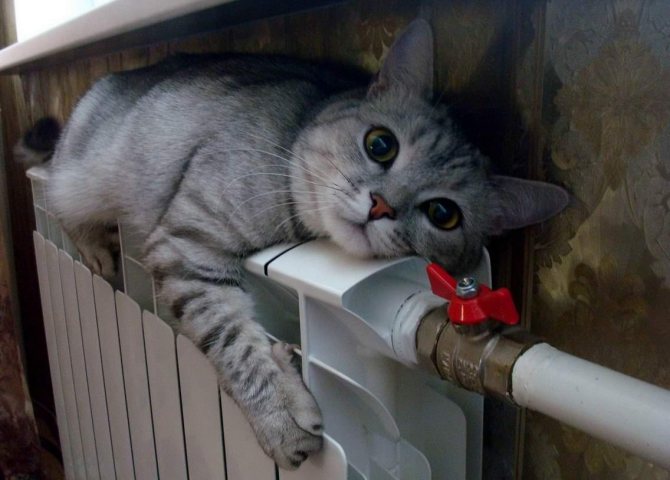

This system has central heating. With its help, multimillion cities are heated. However, you have to pay for such services.
End of the heating season
The end of the heating season is also of great importance. After all, everyone wants to know when their home will cease to be heated. Therefore, the whole country is closely following the news about this day.
The end of the heating season, like its beginning, cannot be predicted. The fact is that it is impossible to determine exactly when it will be warm outside. Actually for this, according to the new rules, the timing of the heating season may vary.
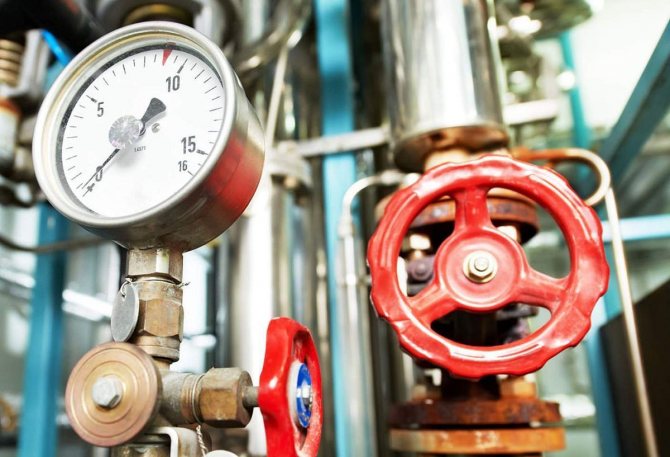

You can guess when the heating season will end by taking last year's figures into account. For example, in 2020, heating in Moscow was turned off on May 2. Consequently, we can expect that Muscovites will stop heating at about the same time in 2020. However, this forecast is not accurate, since frosts may drag on, or, on the contrary, the winter will be short. However, central heating also has its negative factors.
Cons of central heating:
- Central heating works non-stop, therefore, during the heating season, the air in the apartment is very dry;
- Sometimes, in strong porosity, pipes in the heating system can burst, because of this, interruptions are possible;
- The intensity level of the central heating cannot be adjusted, so some people may feel discomfort.
As you can see, the central heating is faulty. Therefore, many people have switched to autonomous heating of their homes.
Reducing clearance in old heating pipes
Lime deposits and rust reduce the inner diameter of the metal pipe by more than half
In the old "Khrushchev" buildings, problems in the heating system are obvious and predictable. The service life of pipelines there has long expired, and therefore they cause not only a decrease in heat, but also accidents. For many decades, pipes have become so clogged with deposits that they are unable to provide normal circulation. The solution should be cardinal - to replace all pipes.
In addition, a decrease in pressure in the system is caused by the formation of scale on the heat exchanger of the heating boiler. The use of too hard water leads to such consequences. To prevent such a problem with heating devices, special reagents are added to the system to soften the water.
Where to call
hydraulic tests in a hot water settlement
According to Russian legislation, namely, Article 5 of the "Rules for the provision of utilities to owners and users of premises in apartment buildings and residential buildings": "The heating period must start no later than and end no earlier than the day following the day of the end of the 5-day period, during which, respectively, the average daily outside temperature is below 8 degrees Celsius ...
»Thus, the start of the heating season depends on the weather conditions.
The approximate period for the beginning of the 2016/2017 heating season in Moscow is October 4-10, 2020.
Heat supply procedure
Two weeks before the heating is turned on, test runs are carried out in order to identify breakdowns and leaks.The first, where the launches are carried out and the first to turn on the heating are social facilities: hospitals, schools and kindergartens. After the start of the heating season at these facilities, heat is supplied to the residential sector (apartments).
What should be the temperature in the apartment? Legal requirements
According to the "Rules for the provision of utilities:
- In residential premises, the temperature should not be lower than +18 ° C
- In the corner rooms of living quarters, the temperature should not be lower than +20 ° C
- In the kitchen - not lower than +18 ° C
- In the bathroom - not lower than +25 ° C
- In the toilet - not lower than +18 ° C
- At night (from 00.00 to 5.00 hours), the air temperature in the apartment can drop by no more than 4 ° C
- In the daytime, temperature drops below the standard level are not allowed
How to correctly measure the temperature in an apartment?
It is necessary to place the measuring device in the center of the room, at the intersection of the diagonals between the corners, at a height of 1 meter from the floor.
Requirements for an allowable interruption in the supply of heat in accordance with the "Rules for the provision of communal services to owners and users of premises in apartment buildings and residential buildings":
- No more than 24 hours (in total) within 1 month
- No more than 16 hours at a time - at an air temperature in residential premises from + 12 ° С
- No more than 8 hours at a time - at an air temperature in residential premises from + 10 ° С to + 12 ° С
- No more than 4 hours at a time - at an air temperature in residential premises from + 8 ° С to + 10 ° С
For each hour of exceeding the permissible duration of the heating break, calculated in total for the billing period, the amount of the utility bill is reduced by 0.15%.
Technical Difficulties
If all the documentation meets the requirements, the apartment re-equipment project has been approved, the type of autonomous heating source meets the fire safety standards and operating conditions in an apartment building, you can expect a permit. Another thing is that such actions on the part of public utilities do not meet with enthusiasm and the bureaucratic procedure can take months.
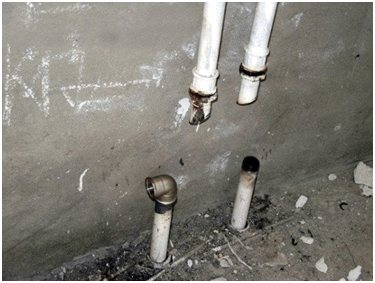

Regarding the technical side of the matter, the task of disconnecting the apartment from the centralized heating does not look difficult. To solve it, you just need to invite qualified workers. Dismantling of existing equipment and subsequent installation of an autonomous heating system is carried out in strict accordance with the project, with the participation of specialists.
Otherwise, you may face a number of problems, first of a technical plan, and then of an administrative one.
ATTENTION: IN CONNECTION WITH THE EMERGING OBLIGATION TO INCLUDE INTO THE REPAIR FUND OF TVERSKAYA REGION FROM JULY 01, 2014 PAYMENT FOR REPAIRS, PLEASE REVIEW THE SEPARATED INFORMATION
Leaks
Most often they appear:
- On the oil seals valves, throttles and, less often, ball valves;
- On locknuts in front of the radiators when they are connected to the liners with squeegees;
- Between sections sectional radiator;
- At the seams electrowelded water and gas pipes.
Omentum
Description: The rotating stem is sealed with a gland packing, rubber or PTFE packing ring. A gland is a ring that pushes the stem seal into the body. This ring is pressed with a union nut.
Leak occurs when the stuffing box is worn out or when the O-ring is worn.
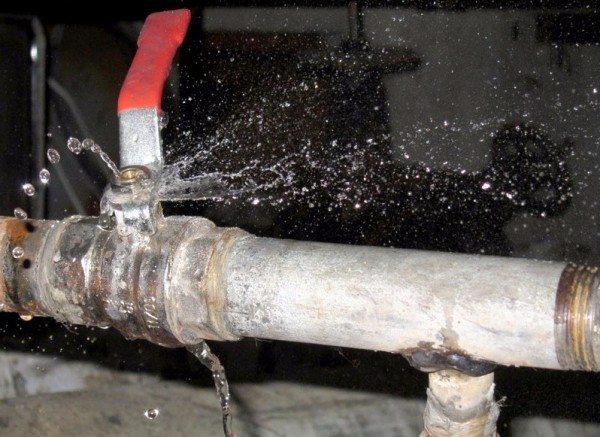

Leaking from the ball valve oil seal.
Decision:
- For valves with a rubber or PTFE sealing ring, it is enough to tighten the gland nut by 1-2 turns. The ring flattened by pressure will crimp the stem, and the flow will stop;
On ball valves, in especially neglected cases, laying several turns of FUM tape under the gland helps. The gland nut must be unscrewed with the valve completely closed.
- For valves with stuffing box packing, several turns of the graphite stuffing box thread are placed under the stuffing box.In this case, during the repair work, the heating (the entire circuit or a separate riser) will have to be reset: even with the valve closed above its valve, excess pressure will be present under the stuffing box. Here are the step-by-step instructions for stuffing the gland:
Related article: Copper-aluminum heating radiators: some convincing facts
| Illustration | Actions |
| Close the valve all the way. Otherwise the threads on the stem will compress the packing from below and prevent you from sealing the packing. |
| Unscrew the nut oil seals with an open-ended or adjustable wrench. If the lamb gets in the way, remove it. |
| Take out the omentumprying it off with a screwdriver. |
| Pack the stuffing box... To do this, wind several turns of thread on the stem, pressing each turn with a screwdriver into the gap between the stem and the body. |
Lock-nut
Description: the locknut ensures the tightness of the connection of the squeegee (long-thread branch pipe) with the radiator plug, coupling, angle, etc. Over time, the organic coils will fade due to the high operating temperature and the joint will leak.
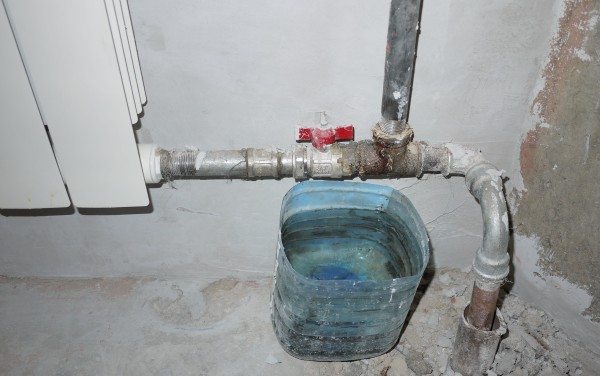

Leaking locknuts at the jumper-to-tee connection.
Decision: when the heating is reset, give the lock nut a few turns and rewind it with sanitary flax soaked in any paint on an organic solvent. The paint will prevent flax from fading again. Do not overtighten the nut to avoid stripping the threads on it.
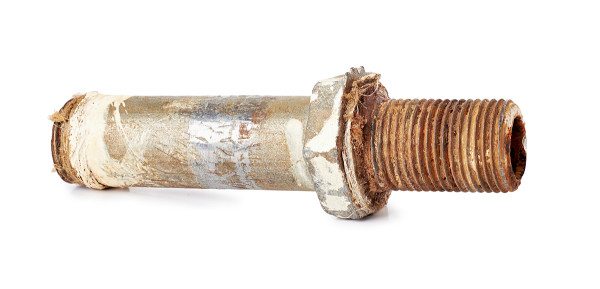

Ride with reel. Linen impregnated with paint will last for decades.
I emphasize that heating (circuit or riser) should not just be stopped, but reset. If the rusted threads come off when the connection is disassembled (and this happens periodically), your home and several apartments down the riser will be flooded with hot and dirty water.
Between sections
Description: the reason for the appearance of leaks is the loss of elasticity of the rubber gaskets between the sections. When heated, the sections behave in the same way as any other physical bodies - they expand and squeeze the gasket harder. When cooled, the hard rubber ceases to seal the joint, and the plumbing, so dear to the heart, begins to drip.
Decision: the connection is disassembled with a radiator wrench inserted into the manifold from the end of the radiator and assembled with new gaskets.
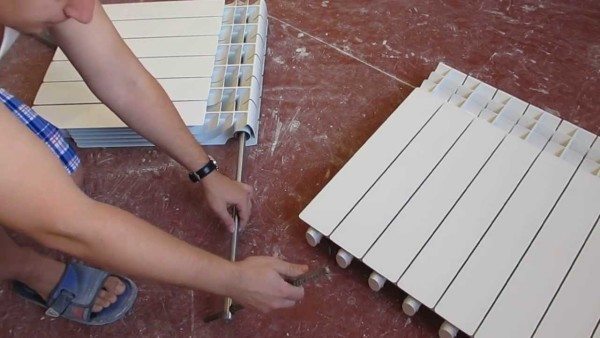

Dismantling the radiator to replace the intersection gaskets.
Plugs (deaf or straight through) must first be unscrewed; when disassembling from the side of the passage plugs, the battery will have to be first disconnected from the connections.
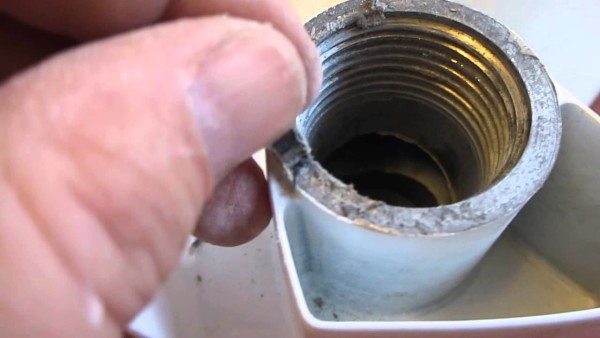

Bulkhead of the old radiator. Remember to remove the old gaskets.
A few subtleties:
- If the key is inserted from the side of the blind plug, to disconnect the sections, it must be rotated clockwise (reverse thread);
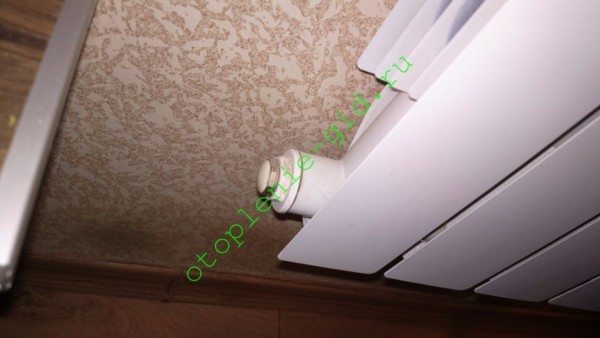

On the side of the blind plug, there is usually a left-hand thread. It unscrews clockwise.
- When unscrewing and screwing in the nipple, do no more than two turns at a time and go to the second nipple. So you can avoid misalignment of the thread with jamming of the nipple;
- If you don't have ready-made spacers at your disposal, use scissors from an old car or bicycle tube to cut them.
At the seam
Description: leakage at the seams of electric-welded pipes is a common disease of all heating and water supply systems made of black steel. The longitudinal seam is the most vulnerable point of the pipe, rolled from a steel tape and welded along the joint. This is where thin steel is most susceptible to corrosion.
Localization: Sometimes a layer of paint makes it difficult to find the exact location of the leak. Scrub away paint and rust with a knife or wire brush and you will see a small fountain of water. A clue can be a rusty drip on the paint: the fistula is always at its beginning.
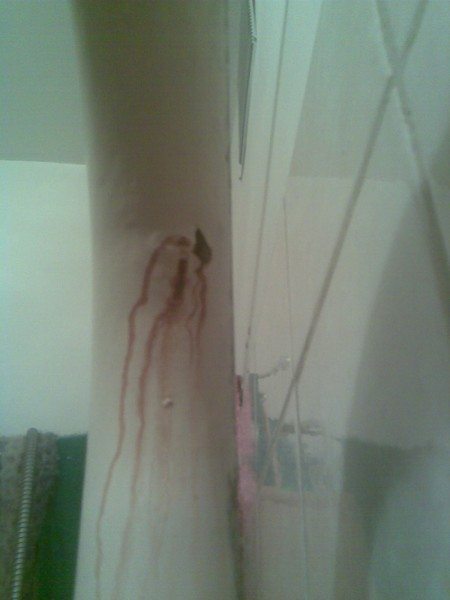

A rusty drip on the pipe allows you to quickly find the leak.
Decision: depending on the scale of the disaster, the repair of the heating system is reduced to welding a fistula or replacing a section of the pipeline.In an apartment building, this work is usually performed by a management company, and absolutely free of charge for residents.
A bandage applied to the leak will help as a temporary solution. For him you will need:
- A piece of thick rubber (for example, a gasket for a crane box without a hole for a fastening screw);
- An aluminum clamp or a piece of knitting wire.
The pipe around the fistula is cleaned of paint and rust, after which the rubber band is pressed against the problem area and pulled together with a clamp.
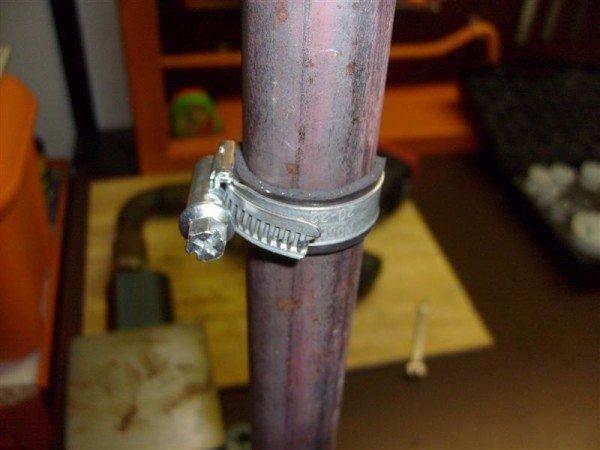

Riser band: an aluminum clamp holds the rubber band against the leak.
Such a heating repair is positioned as temporary, but a bandage with an aluminum clamp or thick copper wire serves indefinitely. I have seen bandages that have stood for 20-30 years.
Preliminary work
Start and end of the heating season
The beginning of the period for supplying heat supply to apartments depends on the subject of the Russian Federation. It is necessary to include the resource in the houses according to the law from October 1 to 15. The completion of heating works falls on the first days of April to mid-May.
rules
According to the law, the leadership of the local municipality must agree on the start and end dates of the heat supply period with the higher authorities. At the same time, the average temperature at which the heating is turned on is + 8 ° C.
CHP plants and utilities are responsible for maintaining the required resource level in residential apartments. The table shows the standards:
Table 2.
| Heated room type | The rate below which the temperature inside the property should not fall. Condition - the room is thermally insulated. |
| Apartment in MKD, private house | 18-20 ° C. If it is below -30 ° С outside, then the indicator increases by 2 ° |
| The room where people work | 20 ° C |
| Classrooms at schools | 18 ° C |
| Playgrounds in kindergartens | 22 ° C |
| Preschool bedrooms | 19 ° C |
| Entrances, corridors, stairways in the MKD | 16 ° C |
Features of the regions
Due to the fact that Russia occupies a large territory and is located in several climatic zones, it stretches far to the north. Of course, the weather conditions are different, so the final decision on heat issues in a particular region lies with the local municipality.
For example, this year, they stopped the supply of heat:
- disconnected in Moscow on 04/26/2019;
- Tula - 04/28/2019;
- Yaroslavl - 04.24.2019;
- Tver - 04/29/2019.
Judicial practice on transferring an apartment in an apartment building to an individual heating system
Please note: if you purchased an apartment while married, it belongs to you and your spouse. Then both of you must sign the application for changing the heating system. Signatures must be put in the presence of an employee of the city administration, an employee of the MFC or a notary. You will have to pay extra for notary services.
According to advertisements on the Internet, a project for a decentralized heating system for an apartment in Moscow costs from 80 to 150 rubles per square meter. The advertising prices indicate the minimum cost of the finished project, for example, 13 thousand rubles for 80 m², and it is higher than the calculated area. In addition, heating projects involve a lot of fractional work, so the final cost can be much higher than the estimated one.
After installing a new heating system, an acceptance committee must be invited, which will confirm that the system corresponds to the project and can be safely operated. If everything goes well, you will receive an act of completion of the apartment renovation. The acceptance committee will send another act to the city administration.
As you can see, giving up central heating takes a lot of time and money. It might be cheaper to just pay for the heating. But it's up to you to decide.
Transferring heating to apartment heating in an apartment building means completely abandoning the central system.This procedure leads to the re-equipment of all engineering communications and devices with the subsequent entry of information into the passport of the object.
According to Art. №25 ZhK Russia such events are referred to as "reorganization of an apartment, house."
- project creation;
- getting permission;
- drawing up an act of commissioning;
- other.
Replacing heating devices used to heat an apartment in an apartment building means that it is necessary to coordinate all actions. This procedure falls under article 25 of the RF LC and clause 1.7.1 of the “Rules and Norms for the Operation of Housing and Communal Services” (PP №170).
IO contour diagram.
In Art. No. 26 of the ZhK of the Russian Federation indicates that it is necessary to re-equip housing only after agreement with the authorized department of local importance. Moreover, you need to comply with the requirements and standards, as well as wait for the publication of the decision.
Re-equipment of the room must be carried out in agreement with the department responsible for the territory on which the high-rise building is located. To do this, the owner must submit an application. The document template was approved in the GD # 266 dated April 28, 05.
We invite you to familiarize yourself with the onerous terms of the transaction
In addition to the application, the citizen is required to collect papers, the list of which is highlighted in Art. №26 LCD of Russia. The provisions of the code also provide a list of technical documents. The project is properly drawn up for the correct installation of individual heating. The heat supply source can be gas or powered.
The project is ordered from special companies. The citizen should request certificates confirming the right of admission to such events. The certificate is issued by the municipality of the construction sector.
During the installation of heating units in an apartment, it is necessary to make sure that the technical parameters are correct.
- sanitary and epidemiological conclusion, confirmed by a certificate;
- permission from Rostekhnadzor;
- certificate of conformity.
Due to the fact that the heating system in an apartment building is a common property, the reduction of its area should be carried out with the consent of all owners. A similar situation is associated with the ongoing re-equipment of the heat supply in at least one room. The norm is enshrined in article No. 36 of part No. 3 of the ZhK of Russia.
Thus, wishing to refuse heating in an apartment building, the applicant must obtain permission not only from the municipality, but also enlist the support of the owners of the apartment building.
If a person is going to arbitrarily disconnect from the central system, then the actions are regarded as unauthorized misalignment of the engineering networks of the house. It does not matter whether it is a panel MCD or a brick one - in any case, events entail incorrect resource allocation, overheating of communications or underheating of individual premises.
Note: an illegal switch to individual heating in an apartment inexorably leads to disruption of the entire system and an increase in fuel consumption. This is due to the fact that during the construction of the project, a certain diameter of pipes on the main line was laid.
When a part of consumers living in apartment blocks is de-energized, the power reserve in the boiler room increases. Such actions adversely affect the operation of the supplier, as well as negatively affect the quality of the services provided. For example, the tariff for heat rises, which entails a violation of the rights of other citizens.
Examples of the use of air source heat pumps for heating apartments.
In order to legally shut off the heating in the apartment and connect individual heat supply, it is necessary to contact the administration of the settlement with the documentation. Additionally, you can submit paper through the MFC.
As a rule, these departments send a refusal to register and register refurbishment. Officials are motivated by the fact that the project does not comply with the current norms and standards, or that the papers lack some information.
However, it must be understood that the actual ground for refusal is:
- Officials of the authorities do not want to take responsibility for issuing permission to carry out the reorganization of the premises, since shortcomings and errors in calculations can lead to emergency recognition of the house.
- For housing and communal services and supplier enterprises, such a process is unprofitable, since it leads to a decrease in the amounts in receipts.
In the event of a disputable situation, citizens need to apply to the judicial authorities.
- Request. The text of the document must contain the address of the apartment where the refurbishment is planned. Sighting is carried out by all owners. Additionally, the approximate scope of work and other technical indicators are indicated.
- Certificate confirming the ownership of the apartment - purchase agreement, lease, property certificate.
- Residential refurbishment project.
- Technical passport.
- Written consent of all citizens living at the facility to install an individual heat supply system.
- Conclusion from the department for the protection of architectural heritage and admission for redevelopment. This document is required if a private or apartment building is recognized as a cultural monument.
The main problem when installing gas or electrical equipment for heating is that the apartment building already has a common heat supply system. The owners of the highway are the owners of the premises.
- the system belongs to a number of persons;
- is an element of a large engineering network owned by the supplier and housing and communal services.
- form a project;
- choose the correct communication elements and equipment;
- install the system so that the rights of other citizens are not affected, and not increase the risk of an accident.
Therefore, the first stage is to coordinate the upcoming events with the owners of the apartment building, and not only with the municipality.
Installation of autonomous heating in MKD is endowed with a number of nuances. So, when installing, citizens are faced with the problem of formalizing and legitimizing the procedure. The disadvantage of individual heat supply is the fact that it is necessary to select heating elements, since the main mistakes relate to technology.
In legal practice, owners are often faced with a refusal to satisfy a claim. Such a verdict is often due to the risk of deterioration in the living conditions of the owners of apartment blocks. These requirements are spelled out in the order of the State Construction Committee of the Russian Federation No. 170.
In the absence of the opportunity to independently deal with the difficulties and technical documents, experts recommend contacting a project company. In some constituent entities of the country, such work is carried out by employees of the departments of the gas company. Services are provided according to a separate price list.
An autonomous heating system is both a comfort and a benefit, but the use of this opportunity requires overcoming the obstacles associated with obtaining permits. In addition, it is necessary to choose the right gas heating boiler and order installation from employees. For 2020, there are many judicial precedents that allow the installation of individual heating.
It is possible to abandon the central resource supply system and switch to autonomous heat consumption. But the problems of such events are rooted in the need to obtain a solution from all owners of MKD. In addition, it will be necessary to disassemble communications and coordinate activities with the RNO, the management company and housing and communal services.
To obtain permission from other apartment owners, it is required to bring the issue to the meeting. During the voting, it will become clear whether to act further or not.
When to start heating after winter
The question of turning on the batteries worries citizens as much as turning them off.
To find out the approximate time frame, you need to find out what conditions the heating companies will be guided by:
- Within 5 days, the average temperature outside the window should be no more than 8 ° C. This mark was not chosen by chance. If you move the dates, then there will be a possibility of freezing of the heating system, especially in the entrances of residential buildings. If such a situation arises, the building will be in an emergency position, and repairs will be expensive.
- The heating system is turned on from October 1 to October 15. Previously, it is impractical to start heating supply, since the process is laborious and costly.
- Experts also take into account the weather forecast for the next month. If there is a sharp warming in a few days, then it makes no sense to turn on the batteries in the houses. The consumer will have to pay money for the wasted heat supply.
Starting a heating system is always associated with a large number of overlays. Heating mains quickly gain the required power, but heating does not appear in radiators immediately.
Note: there is air in the system, which blocks the flow of heat. To solve the problem with the low temperature in the apartment, the owner must release it on his own. To do this, open two valves located on the radiators.
Heating system imbalance
Serious problems with heating in an apartment building arise when residents start renovating and redeveloping their apartments. Spontaneous, uncontrolled installation of new radiators and underfloor heating leads to an imbalance in the system. As a result, the circulation in the system is disrupted, on some floors the batteries are hot, and on others the residents are freezing. The specialists of the management company can balance the distribution of the coolant along the risers, but problems with heating in individual apartments still remain.
If the neighbors have changed their heating devices and removed the thermostats, then it is not surprising that water simply will not go through pipes to your apartment. And it will be possible to solve such a problem with heating only by removing the thermostat also at home.
Another opportunity to really increase the heat flow to your apartment is to follow the example of your neighbors and change the batteries. If you install aluminum or bimetallic instead of cast iron, their heat transfer will be much better.
It is forbidden to change radiators without permission, you need to get permission!
The heating system can also be unbalanced in a private house. Then the radiators located closer to the boiler heat up more than the distant ones. It will be necessary to restore the balance in this way: close the control taps and restrict the flow of coolant entering the near radiators so that more heat can be supplied to the distant ones.

